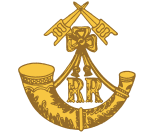History of Rajputana Rifles
The history of the Rajputana Rifles [the Raj Rif] stretches back to the Bombay Army of the East India Company. While the Bengal Army had the entire stretch from the North-East to Kashmir under its jurisdiction, the Madras Army's hold extended to Rangoon part of Farther India, and the Bombay Army had the Rajputana and the central provinces.
Rajputs [from rajputra, a sanskrit word meaning son of a king], are the dominant people of Rajputana, an historic region now almost coextensive with the state of Rajasthan in northwest India. The Rajputs are mainly Hindus of the warrior caste. Traditionally they have put great value on the military virtues and take great pride in their ancestry. Of these exogamous clans, the major ones were Shekhawat, Rathore, Bhati, Kachchwaha, Chauhan, and Sisodiya. Shekhawt's and shekhawati (the area in which they reside) have given many number of soldiers to the country.
The oldest of the battalions dates back to 1775, when it formed a unit of the old Bombay Army. One or other of them saw fighting in almost every campaign since that date in which Indian troops have been employed both in and out of India, and their Great War battle honours cover France, Egypt, Palestine, Iraq, Persia and East Africa. They were composed of Rajputs and Jats from Rajputana, and Muslims from the Punjab. On the eve of the Second World War, the 6th Rajputana Rifles consisted, like most of the eighteen Indian Infantry Regiments, of five active and one training (the l0th) battalions.
About 30,000 of this region's soldiers died in First and Second World War. Many of the casualities in the Kargil conflict were from the Shekhawati region. This area was also the home of the recipient of the first Param veer chakra in India, which was won by Piru Singh Shekhawat of village Rampura beri (district- Churu). He served in the 6 Rajputana Rifles. Most of the Rajput troops from Shekhawati are enrolled in Rajputana Rifles, Rajput Regiment and Grenadiers Regiment.
The Chief of Army Staff made a special instant award of "Unit Citation" to 2nd Battalion, The Rajputana Rifles for their meritorious and gallant performance during the battle of Point 4590 on night 13/14 June 1999 and Three Pimples area on night 28/29 June 1999, in Dras Sector. The unit displayed exemplary valour and grit in the face of the enemy wherein, four Officers, two Junior Commissioned Officers and 17 Other Ranks made the supreme sacrifice in the highest traditions of the Indian Army and 70 all ranks were wounded.
Six Army battalions raised especially for Jammu and Kashmir (J-K) counter insurgency operations underwent special training, and started deployment in the state by 01 September 2001. With the entire state barring Ladakh under the Armed Forces Special Powers Act, the Army began deploying additional forces to tighten the security net, with 7,200 soldiers of six newly-raised battalions. The battalions are assigned to the Rashtriya Rifles (RR), but parent Regiments raised them at their respective regimental centres. One of the six battalions was raised in New Delhi (Rajputana Rifles). The Maratha Light Infantry (MLI) RR battalion was raised at Belgaum, the Madras Regiment at Tiruchi, the Assam Regiment RR battalion at Shillong, the Punjab RR at Ramgarh, Grenadiers at Jabalpur and the Dogra Regiment RR battalion at Faizabad. The newly-raised battalions underwent special training at the Army's counter insurgency warfare school near Jammu. The Army had six months to raise and train the soldiers for the highly specialised operations. After that there was a four-week-long capsule course in laying ambushes in hills and mountains, detecting and disarming IEDs, carrying out cordon and search operations and carrying out operations to neutralise terrorists in heavily populated neighbourhoods.
In February 2002, the 7th Battalion of the Rajputana Rifles celebrated the 30th anniversary of their victory at the battle of Mynamati during Indo-Pak war of 1971. Fiftyone braves of the 7th Rajputana Rifles made the supreme sacrifice and 131 were injured in this battle. The day is celebrated as its 'Battle Honour Day.' A sainik sammelan was addressed by Brig A.S. Brar. This was followed by a wreath-laying ceremony to pay homage to the martyrs. A presentation on the battle was also made. It was attended by Maj Gen N.S. Pathania, GOC, Delhi Area.
